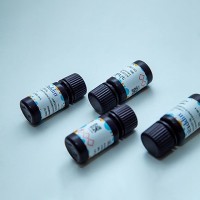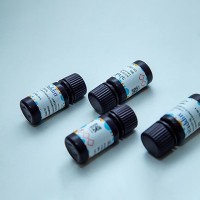Synthesis of Triazole‐Nucleoside Phosphoramidites and Their Use in Solid‐Phase Oligonucleotide Synthesis
互联网
- Abstract
- Table of Contents
- Materials
- Figures
- Literature Cited
Abstract
Triazole?backbone oligonucleotides are macromolecules that have one or more triazole units that are acting as a backbone mimic. Triazoles within the backbone have been used within oligonucleotides for a variety of applications. This unit describes the preparation and synthesis of two triazole?nucleoside phosphoramidites [uracil?triazole?uracil (UtU) and cytosine?triazole?uracil (CtU)] based on a PNA?like scaffold, and their incorporation within oligonucleotides. Curr. Protoc. Nucleic Acid Chem . 55:4.57.1?4.57.38. © 2013 by John Wiley & Sons, Inc.
Keywords: triazole?linkage; cycloaddition; phosphoramidite; solid?phase oligonucleotide synthesis
Table of Contents
- Introduction
- Basic Protocol 1: Preparation of Uracil and Cytosine Pyrimidine Bases
- Basic Protocol 2: Preparation of Alkyne and Azide Linkers
- Basic Protocol 3: Preparation of Alkyne and Azide Monomers
- Basic Protocol 4: Preparation of Uracil‐Triazole‐Uracil Phosphoramidite (24)
- Basic Protocol 5: Preparation of Cytosine‐Triazole‐Uracil Phosphoramidite
- Basic Protocol 6: Synthesis, Purification, and Characterization of Oligonucleotides Containing CtU or UtU Units
- Reagents and Solutions
- Commentary
- Literature Cited
- Figures
- Tables
Materials
Basic Protocol 1: Preparation of Uracil and Cytosine Pyrimidine Bases
Materials
Basic Protocol 2: Preparation of Alkyne and Azide Linkers
Materials
Basic Protocol 3: Preparation of Alkyne and Azide Monomers
Materials
Basic Protocol 4: Preparation of Uracil‐Triazole‐Uracil Phosphoramidite (24)
Materials
Basic Protocol 5: Preparation of Cytosine‐Triazole‐Uracil Phosphoramidite
Materials
Basic Protocol 6: Synthesis, Purification, and Characterization of Oligonucleotides Containing CtU or UtU Units
Materials
|
Figures
-
Figure 4.57.1 General scheme for the conversion of uracil into uracil‐1‐yl acetic acid (2 ) and cytosine into ( N 4 ‐(benzoyl)cytosine‐1‐yl)acetic acid (5 ). View Image -
Figure 4.57.2 General scheme for the preparation of alkyne linker 8 and azide linkers 11 and 14 . View Image -
Figure 4.57.3 General scheme for the preparation of alkyne monomer 15 and azide monomers 16 and 19 . View Image -
Figure 4.57.4 General scheme for the preparation of the uracil‐triazole‐uracil dimer phosphoramidite (24 ). View Image -
Figure 4.57.5 General scheme for the preparation of the cytosine‐triazole‐uracil dimer phosphoramidite (27 ). View Image
Videos
Literature Cited
| Literature Cited | |
| Boren, B.C., Narayan, S., Rasmussen, L.K., Zhang, L., Zhao, H., Lin, Z., Jia, G., and Fokin, V.V. 2008. Ruthenium‐catalyzed azide‐alkyne cycloaddition: Scope and mechanism. J. Am. Chem. Soc. 130:8923‐8930. | |
| Caruthers, M.H. 1985. Gene synthesis machines: DNA chemistry and its uses. Science 230:281‐285. | |
| Chandrasekhar, S., Srihari, P., Nagesh, C., Kiranmai, N., Nagesh, N., and Idris, M.M. 2010. Synthesis of readily accessible triazole‐linked dimer deoxynucleoside phosphoramidite for solid‐phase oligonucleotide synthesis. Synthesis 10:3710‐3714. | |
| Chittepu, P., Sirivolu, V.R., and Seela, F. 2008. Nucleosides and oligonucleotides containing 1,2,3‐triazole residues with nucleobase tethers: Synthesis via the azide‐alkyne ‘click’ reaction. Bioorg. Med. Chem. Lett. 16:8427‐8439. | |
| Christensen, L., Hansen, H.F., Koch, T., and Nielsen, P.E. 1998. Inhibition of PNA triplex formation by N‐4‐benzoylated cytosine. Nucleic Acids Res. 26:2735‐2739. | |
| Dodd, D.W., Swanick, K.N., Price, J.T., Brazeau, A.L., Ferguson, M.J., Jones, N.D., and Hudson, R.H.E. 2010. Blue fluorescent deoxycytidine analogues: Convergent synthesis, solid‐state and electronic structure, and solvatochromism. Org. Biomol. Chem. 8:663‐666. | |
| Efthymiou, T.C. and Desaulniers, J.‐P. 2011. Synthesis and properties of oligonucleotides that contain a triazole‐linked nucleic acid dimer. J. Heterocycl. Chem. 48:533‐539. | |
| Efthymiou, T., Gong, W., and Desaulniers, J.‐P. 2012a. Chemical architecture and applications of nucleic acid derivatives containing 1,2,3‐triazole functionalities synthesized via click chemistry. Molecules 17:12665‐12703. | |
| Efthymiou, T.C., Vanthi, H., Oentoro, J., Peel, B., and Desaulniers, J.‐P. 2012b. Efficient synthesis and cell‐based silencing activity of siRNAs that contain triazole backbone linkages. Bioorg. Med. Chem. Lett. 22:1722‐1726. | |
| El‐Sagheer, A.H. and Brown, T. 2009. Synthesis and polymerase chain reaction amplification of DNA strands containing an unnatural triazole linkage. J. Am. Chem. Soc. 131:3958‐3964. | |
| El‐Sagheer, A.H. and Brown, T. 2010. New strategy for the synthesis of chemically modified RNA constructs exemplified by hairpin and hammerhead ribozymes. Proc. Natl. Acad. USA 107:15329‐15334. | |
| Fujino, T., Yamazaki, N., and Isobe, H. 2009. Convergent synthesis of oligomers of triazole‐linked DNA analogue (TLDNA) in solution phase. Tetrahedron Lett. 50:4101‐4103. | |
| Fujino, T., Endo, K., Yamazaki, N., and Isobe, H. 2012. Synthesis of triazole‐linked analogues of RNA ((TL)RNA). Chem. Lett. 41:403‐405. | |
| Gramlich, P.M.E., Warncke, S., Gierlich, J., and Carell, T. 2008. Click‐click‐click: Single to triple modification of DNA. Angew. Chem. Int. Ed. 47:3442‐3444. | |
| Huisgen, R., Szeimies, G., and Mobius, L. 1967. 1.3‐dipolar Cycloadditionen 32. Kinetik der Additionen organischer Azide an CC‐Mehrfachbindungen. Chem. Ber. 100:2494‐2507. | |
| Ingale, S.A. and Seela, F. 2013. Stepwise click functionalization of DNA through a bifunctional azide with a chelating and a nonchelating azido group. J. Org. Chem. 78:3394‐3399. | |
| Isobe, H., Fujino, T., Yamazaki, N., Guillot‐Nieckowski, M., and Nakamura, E. 2008. Triazole‐linked analogue of deoxyribonucleic acid ((TL)DNA): Design, synthesis, and double‐strand formation with natural DNA. Org. Lett. 10:3729‐3732. | |
| Kolb, H.C. and Sharpless, K.B. 2003. The growing impact of click chemistry on drug discovery. Drug Discov. Today 8:1128‐1137. | |
| Liu, X.J., Chen, R.Y., Weng, L.H., and Leng, X.B. 2000. Synthesis and structure of novel phosphonodipeptides containing a uracil or thymine group. Heteroatom. Chem. 11:422‐427. | |
| Lucas, R., Neto, V., Hadj Bouazza, A., Zerrouki, R., Granet, R., Krausz, P., and Champavier, Y. 2008. Microwave‐assisted synthesis of a triazole‐linked 3′‐5′ dithymidine using click chemistry. Tetrahedron Lett. 49:1004‐1007. | |
| Mayer, T. and Maier, M.E. 2007. Design and synthesis of a tag‐free chemical probe for photoaffinity labeling. Eur. J. Org. Chem. 2007:4711‐4720. | |
| Meldal, M. and Tornoe, C.W. 2008. Cu‐catalyzed azide‐alkyne cycloaddition. Chem. Rev. 108:2952‐3015. | |
| Mutisya, D., Selvam, C., Kennedy, S.D., and Rozners, E. 2011. Synthesis and properties of triazole‐linked RNA. Bioorg. Med. Chem. Lett. 21:3420‐3422. | |
| Rostovtsev, V.V., Green, L.G., Fokin, V.V., and Sharpless, K.B. 2002. A stepwise Huisgen cycloaddition process: Copper(I)‐catalyzed regioselective “ligation” of azides and terminal alkynes. Angew. Chem. Int. Ed. 41:2596‐2599. | |
| Schwarz, D.S., Hutvagner, G., Du, T., Xu, Z.S., Aronin, N., and Zamore, P.D. 2003. Asymmetry in the assembly of the RNAi enzyme complex. Cell 115:199‐208. | |
| Schwergold, C., Depecker, G., Di Giorgio, C., Patino, N., Jossinet, F., Ehresmann, B., Terreux, R., Cabrol‐Bass, D., and Condom, R. 2002. Cyclic PNA hexamer‐based compound: Modelling, synthesis and inhibition of the HIV‐1 RNA dimerization process. Tetrahedron 58:5675‐5687. | |
| Varizhuk, A., Chizhov, A., Smirnov, I., Kaluzhny, D., and Florentiev, V. 2012. Triazole‐linked oligonucleotides with mixed‐base sequences: Synthesis and hybridization properties. Eur. J. Org. Chem. 2012:2173‐2179. | |
| vonMatt, P. and Altmann, K.H. 1997. Replacement of the phosphodiester linkage in oligonucleotides by heterocycles: The effect of triazole‐ and imidazole‐modified backbones on DNA/RNA duplex stability. Bioorg. Med. Chem. Lett. 7:1553‐1556. |



![1-tert-butyl-N-[8-[2-[(1-methylpyrazol-4-yl)amino]pyrimidin-4-yl]-2-(oxetan-3-yl)-1,3,4,5-tetrahydro-2-benzazepin-5-yl]triazole-4-carboxamide,Moligand™,阿拉丁](https://img1.dxycdn.com/p/s14/2024/0619/785/8670042233826733081.jpg!wh200)



